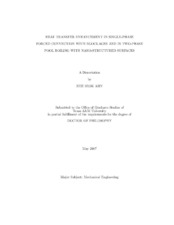| dc.description.abstract | The first study researched turbulent forced convective heat (mass) transfer down-
stream of blockages with round and elongated holes in a rectangular channel. The
blockages and the channel had the same cross section, and a distance equal to twice
the channel height separated consecutive blockages. Naphthalene sublimation experiments were conducted with four hole aspect ratios (hole-width-to-height ratios) and
two hole-to-blockage area ratios (ratios of total hole cross-sectional area to blockage
area). The effects of the hole aspect ratio, for each hole-to-blockage area ratio, on the
local heat (mass) transfer distribution on the exposed primary channel wall between
consecutive blockages were examined. Results showed that the blockages with holes
enhanced the average heat (mass) transfer by up to 8.5 and 7.0 times that for fully
developed turbulent flow through a smooth channel at the same mass flow rate, respectively, in the smaller and larger hole-to-blockage area ratio (or smaller and larger
hole diameter) cases. The elongated holes caused a higher average heat (mass) transfer and a larger spanwise variation of the local heat (mass) transfer on the channel
wall than did the round holes.
The second study explored the heat transfer enhancement for pool boiling on
nano-structured surfaces. Experiments were conducted with three horizontal silicon surfaces, two of which were coated with vertically aligned multi-walled carbon nanotubes (MWCNT) with heights of 9 and 25 ¹m, respectively, and diameters between
8 and 15 nm. The MWCNT arrays were synthesized on the two silicon wafers using
chemical vapor deposition. Experimental results were obtained over the nucleate boiling and film boiling regimes under saturated and sub-cooled (5±C and 10±C) boiling
conditions. PF-5060 was the test fluid. Results showed that the MWCNT array with
a height of 25 ¹m enhanced the nucleate and film boiling heat fluxes on the silicon
surface by up to 380% and 60%, respectively, under saturated boiling conditions, and
by up to 300% and 80%, respectively, under 10±C sub-cooled boiling conditions, over
corresponding heat fluxes on a smooth silicon surface. The MWCNT array with a
height of 9 ¹m enhanced the nucleate boiling heat flux as much as the taller array,
but did not significantly enhance the wall heat flux in the film boiling regime. | en |


